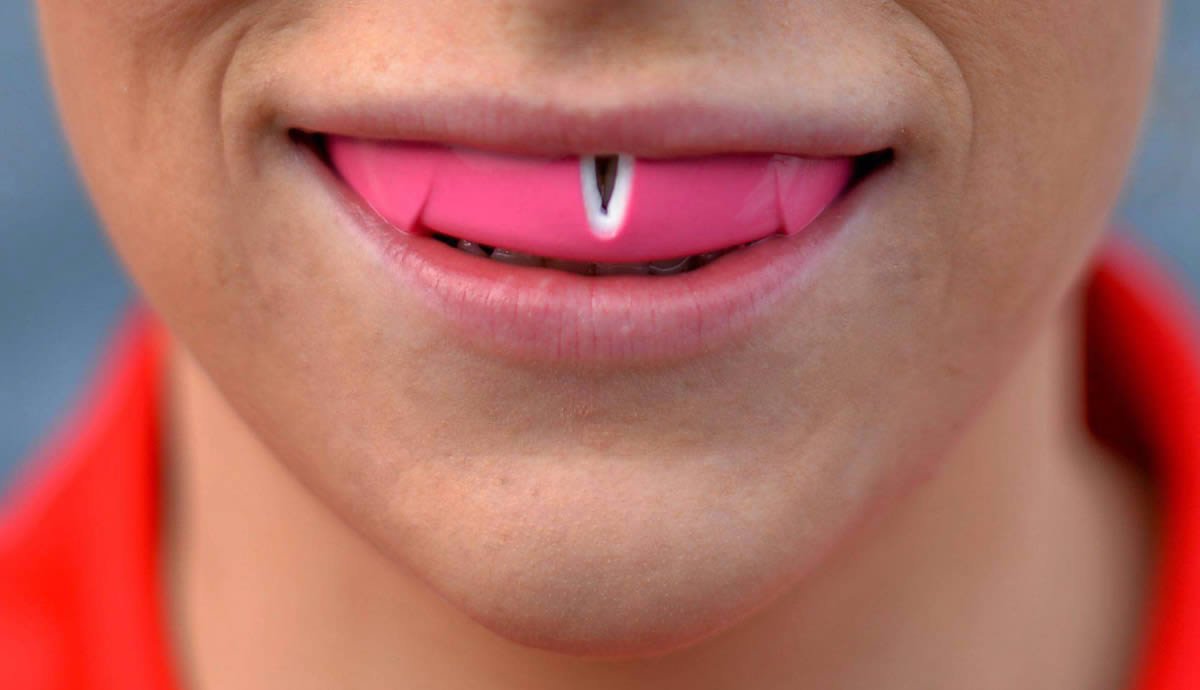
Mouthguards
A mouthguard is a protective layer that covers the teeth, acting to cushion any knock or blow to the mouth and teeth. Generally, sporting mouthguards cover the upper teeth only. Mouthguards are hugely important in limiting the risk of mouth-related injuries to the cheeks, lips, tongue, and teeth, which is why dentists, dental specialists, sports coaches and other professionals highly recommend them!
Mouthguard Info+
Who are they for?
In New Zealand, the average knock to the face initially costs a pile of paperwork, pain, discoloured teeth, unsightly smiles, and poor long-term health of the teeth (even though ACC may cover the financial pain). Mouthguards are for adults and children who play contact sports e.g. rugby, football, martial arts, hockey, basketball, and water polo. However, even non-contact sports can pose a risk of dental injury so a mouthguard should be worn if there is a potential risk of falling over or getting a knock to the face e.g. gymnastics, skateboarding, mountain biking etc. For anyone with anterior fillings, bridges, implants or braces, mouthguards are highly recommended to keep these protected. If these are removable, such as plates or orthodontic retainers, they should be removed during sporting activities.
Profesionally fitted mouthguards
Professionally-fitted mouthguards are custom-made for each individual to be highly accurate, protective and comfortable. They are usually made of 1, 2 or 3 protective layers, which allows them to provide a lot of protection while maintaining maximal comfort. A dentist or orthodontist can make these by taking a mould of your teeth, and the mouthguard is layered, shaped, trimmed and polished over this mould. Because of the work and time involved in making these, and the specialised equipment and materials required, these are more expensive than the other types (approximate cost is around $250-$300, depending on the material used).
Boil and bite mouthguards
Boil and bite mouthguards can also be purchased at many sporting stores. These mouthguards are made from a temperature-sensitive material (thermoplastic), that turns soft when placed in hot water and hardens when cooled. This allows an amount of moulding to fit the shape of the teeth, using finger and tongue pressure. These fit better than the stock standard mouthguards over the teeth and tend to stay in place until removed. For anyone with braces, these are the recommended option. They do lack thickness, which makes them less cushion-like as compared to the custom-made professional mouthguards. The price range is between $20-50.
Stock standard mouthguards
Stock standard mouthguards are pre-formed and are purchased at a supermarket or chemist – they come ready to wear. They are inexpensive ( around $20-50) , however their fit cannot be adjusted… a “one size fits all” approach.They are not recommended by dentists/orthodontists as they are bulky, do not fit snuggly onto teeth, can fall out of the mouth easily, make breathing and talking difficult, and they provide little or no protection.
Looking after your mouthguard
- Rinse your mouthguard with cold water or clean it with mild soap regularly.
- If it is not in your mouth… Keep it safe! Place the mouthguard in a firm, perforated container.
- Protect the mouthguard from hot water, hot surfaces, or direct sunlight, to minimize it distorting its shape.
- Check the mouthguard regularly. If it becomes loose or you find holes, tears or cracks in it, replace it.
© 2025 Shakespeare Orthodontics. | Resources | Privacy Policy
Dr. Adriana Perez
In 2008, Adriana graduated with a Bachelor of Dental Surgery from Santa Maria University in Caracas, Venezuela. After graduation, she worked in Venezuela in private practice, at the Orthopaedic Children’s Hospital (Dentistry/Orthodontics unit), and as a lecturer in the National Experimental University of the Armed Forces.
In the year 2011, Adriana moved to Argentina to specialise, gaining the Specialist Orthodontist degree from the University of Buenos Aires in 2013. While in Argentina, she worked as a part-time lecturer at the Orthodontics Department in the University of Buenos Aires, private practice, and at the Craniofacial Unit in the Paediatric Hospital Garrahan, looking after cleft lip new-born, children, and adolescent patients.
Adriana is a Spanish speaker. On her spare time she likes going to the beach, travelling, socialising with friends, playing video games, cooking, and going to the gym.

Dr. Azza Al-Ani
BDS | DClinDent | MRACDS-Orth | MOrthRCSEd
Dr Azza Al-Ani, grew up in Christchurch, is a registered specialist orthodontist working at Shakespeare Orthodontics in Auckland. You can find her at one of the clinics in the city, or at their Takapuna clinic on the North Shore.
In 2009, Azza graduated with a Bachelor of Dental Surgery with Credit from the University of Otago.
She worked as a dental house surgeon at Auckland, Greenlane and Middlemore Hospitals; and as a dental officer at Sydney’s Westmead Hospital.
In 2012, she completed the Royal Australasian College of Dental Surgeons (RACDS) primary examinations.
Before commencing her specialist training, she held a part-time Professional Practice Fellow position at the Faculty of Dentistry, while working as a dentist in private practice.
In 2016, Azza graduated from the University of Otago with a Doctor of Clinical Dentistry in Orthodontics. She passed examinations to gain memberships into the Royal Australasian College of Dental Surgeons and the Royal College of Surgeons of Edinburgh.
She is also certified with the Australasian Orthodontic Board, and is a member of the New Zealand Association of Orthodontists, and the New Zealand Dental Association.
Azza’s area of research interest is hypodontia.
She has presented about this topic at the European Orthodontic Society Congress, and at the International Association Dental Research ANZ Scientific Meeting, and has been involved in the publication of numerous articles in peer-reviewed journals.
Outside of work, Azza loves spending time with her son and Mo (her husband), socialising with family and friends, overseas travel, and tries to keep up with Mo mountain biking.

Dr. Mo Al-Dujaili
Mo is a Specialist Orthodontist. He grew up in both New Zealand and Australia.
After completing a year in Health Sciences, and later physiotherapy, he qualified as a dentist in New Zealand. He spent the next four years working alongside his father in Sydney where he practised general dentistry. Mo then returned to Dunedin to specialise, gaining his specialist degree – Clinical Doctorate in Orthodontics from the University of Otago.
During the three years of specialist training, Mo had the privilege of learning from the best. The combined clinical and academic acumen of professors, doctors and staff provided an invaluable experience.
Meanwhile, Mo published and presented significant research and clinical cases at both national and international forums, including the International Association of Dental Research, the Australasian Begg Society of Orthodontics, the European Orthodontic Society and the New Zealand Dental Association conference.
A firm believer in maintaining high clinical standards, Mo successfully completed further examinations to become affiliated with the Royal College of Surgeons (Edinburgh) and the Royal Australasian College of Dental Surgeons (Sydney).
Mo is currently a part time senior lecturer at Auckland University of Technology, a Fellow of the World Federation of Orthodontists and also holds professional memberships with the New Zealand Association of Orthodontists, the New Zealand Dental Association and American Association of Orthodontists.
He has also been involved in the supervising and lecturing of students at the Auckland University of Technology.
Outside of work, Mo enjoys the precious time with his young family and the outdoors. He especially loves mountain biking, running, fishing, diving and, in winter, snowboarding.
Traveling along with his best friend and wife (Azza) around the world has also been a big part of Mo’s life. Mo is primarily based in Shakespeare Orthodontic’s city clinics and on the North Shore.
